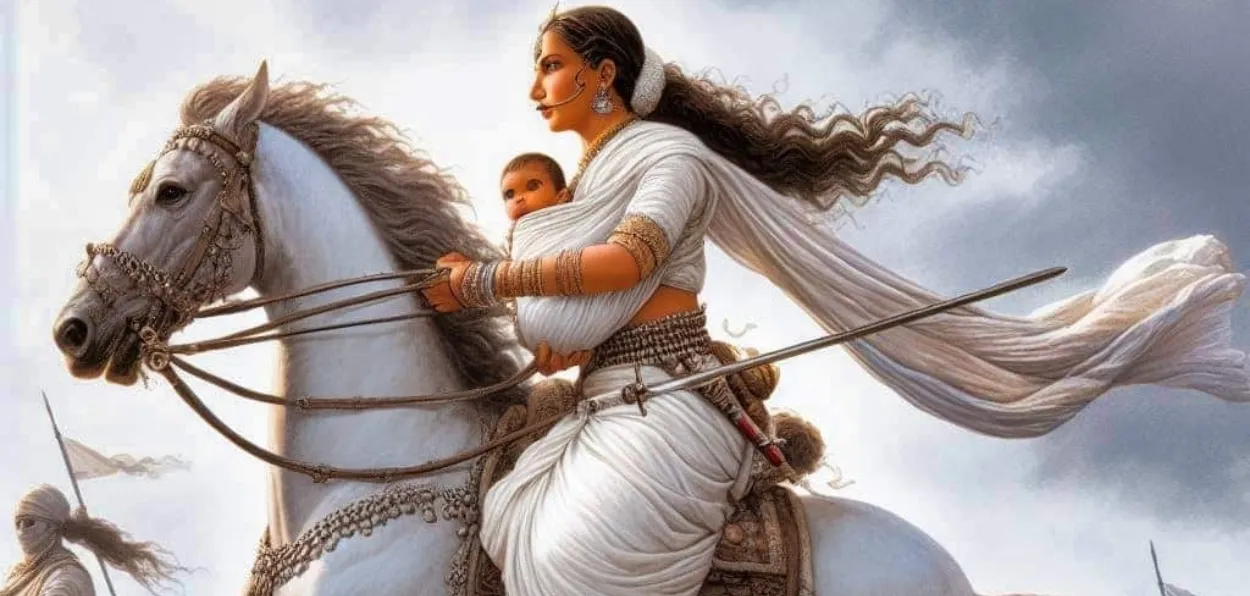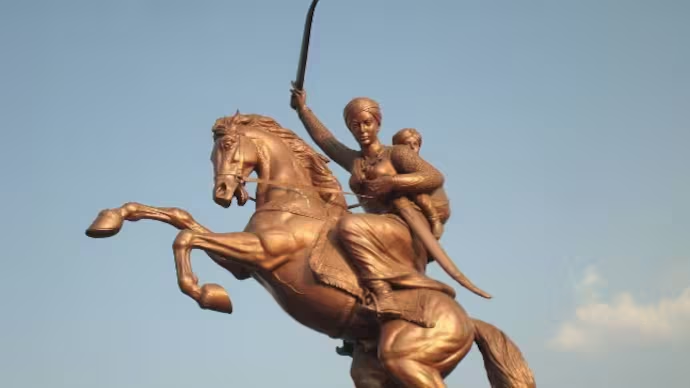
Saquib Salim
Major General Hugh Rose, who led the English forces against Rani Lakshmi Bai of Jhansi in his recommendation letter for English soldiers for the Victoria Cross for their bravery “of which one most important result was the death of the Ranee of Jhansi; who, although a lady, was the bravest and best military leader of the rebels.”
More than 150 years have passed since then. Also, India had seen women warriors before the 1858 war between the Rani and the English forces in 1857. Yet speaking about brave Indian women, Rani Lakshmibai's name takes the paramount position. Though she was 32 at the time of her death, English military records put her age as 24. The 14th (King’s) Hussars noted, “She was a very handsome woman, about 24 years of age, a perfect Amazon in bravery, leading her troops, mounted like a man — just the sort of dare-devil woman that soldiers admire.”
That puts her age approximately equal to that of Bhagat Singh, another Indian revolutionary hero, at the time of their executions. Isn’t it extraordinary that a woman of 24, carved her name in the annals of Indian history like nobody else has ever done? But then she was Rani Lakshmibai of Jhansi.
Why is Lakshmibai important? In the words of D. V. Tahmankar, “Lakshmibai is remembered, above all, because she personified her country's urges and aspirations, hopes and fears, passions and hatreds. She was neither the originator of the Mutiny nor, until its last phase, among its leaders. Yet she made the idea of rebellion a living reality, and turned the half-military, half-feudal revolt, into India's war of independence.
She was a daughter of her age and class, and her conscious objective was limited to regaining sovereignty over her State. She acquired, nevertheless, a sense of mission and of what we now call patriotism. 'To fight against the English,' she declared at the moment of crisis, 'has now become my dharma'- a word that, for its religious overtones, is immensely stronger than the dictionary equivalent of 'duty'.”
Rani was the only one among the leaders of the First War of the Indian Independence of 1857 about whom even the English officers were appreciative. Brigadier Sir John Smyth writes, “This girl (Rani) was an open, intelligent, and honest person, with a strong instinct for fair play. Her tomboyish qualities, her ability to get on with boys, her intelligence, and her generous spirit, seem to show an antithesis to the ultra-feminine, sometimes secretive love of intrigue and acceptance of whatever came along, which marked the character of many Indian women — often from the force of circumstances and upbringing…. The fact that her natural bent was towards the unconventional is born out by the fact that, after the death of her husband, and before the British had refused recognition of her son’s succession and her regency, she at once came out of purdah and went about meeting her people and administering the State in a most just and practical way.
 Rani Lakshmibai's statue in Sholapur, Maharashtra
Rani Lakshmibai's statue in Sholapur, Maharashtra
"Such behaviour was quite out of character in one of her traditions and upbringing, unless one accepts that she was by nature unconventional. When Jhansi was about to be besieged by the British at a later date one of her first actions was to have a party for all the women and encourage them to come out of purdah and help in the work of the siege, bringing food and ammunition to the defenders and tending the sick — a highly practical step, but not one which one would expect.”
“So to the Rani the behaviour of the British over the succession would have appeared an act of such flagrant injustice as to be scarcely bearable. Where you have a person with a strongly-developed sense of justice, and injustice is done, then you have a motivating force strong enough to move mountains. Although her first action was to fight this injustice in any legal way possible, in the end, it was clear there was no redress — and indeed, ultimately she was fighting for her very existence since it was evident that she would be blamed personally for the brutal massacres that took place at Jhansi.”
Both Lord Canning, the Governor-General, and Lord Elphinstone, Governor of the Bombay Presidency, believed that the fall of Jhansi and a defeated Rani was important for re-establishing English rule in India. They believed Jhansi to be the last and most formidable centres of the Indian revolutionaries.
The rise of Rani as one of the undisputed leaders of the First War of Independence becomes even more important considering that even after a century of modern education, feminist movements, and pro-women legislations, it's hard for men to accept a woman as their leader. How did Rani, who had no military experience before 1857, manage to convince men like Rao Sahib or Tantia Tope to accept her as a military advisor and equal army general? She organised her army, chalked out military strategies, and fought along with men on the battlefield.
John Smyth answers this question, “It was not as if she had been brought up in a warlike environment, far from it. Her knowledge must have been purely intuitive, plus an extremely large dose of common-sense and activated by a strong desire to save her throne. Joan of Arc had her voice. Lakshmibai simply had a natural wisdom in these matters. But she was impelled along this path by her single-minded hatred of the British — and, as we know, singleness of purpose is a great concentrator of the mind. So, if one understands her overriding sense of purpose, and adds to that her natural qualities, together with the fact that she had everything to lose that she held dear, it is possible to understand how her achievements came about.”
The Revolutionary leaders like Nawab of Banda, Rao Sahib, Tantia Tope, and others were demoralized by the end of May 1858. The war seemed over for them. It is reported that Rani advised them, “'Let us remember that all through the history of the Mahrata kings they were victorious because they possessed impregnable fortresses. What was true then is equally true now. Was it not the possession of fortresses like Jhansi and Kalpi that enabled us to fight the British for so long? Unfortunately, we have lost them and we cannot make a fight without a strong fort. It is no use trying to run away; the enemy is sure to pursue and destroy us. We must capture a strong fortress and under its protection carry on our struggle till victory is won. I think we should march on Gwalior and obtain the help of the Maharaja and his army. With that fort in our hands, we can still carry on the war and win victory.”
The idea was a military genius. T. R. Holmes in his History of the Indian Mutiny noted, “The idea was as original and daring as that which prompted the memorable seizure of Arcot' (by Clive).” Lord Canning telegraphed to Hamilton: “If Sindhia joins the Mutiny, I shall have to pack off tomorrow.”
Col. Malleson also praised Rani for this plan. He noted, “The situation then seemed desperate to the rebel chieftains. But desperate situations suggest desperate remedies; and a remedy which, on first inspection, might well seem desperate, did occur to the fertile brain of one of the confederates… (Rani) possessed the genius, the daring, and the despair necessary for the conception of great deeds. She was urged on by hatred, by desire for vengeance, by a bloodstained conscience, by a determination to strike hard whilst there was yet a chance. She could recognize the possibilities before her, she could hope even that if the first blow were successful the fortunes of the campaign might be changed; she possessed and exercised unbounded influence over one at least of her companions-the Rao Saheb. The conjecture, then, almost amounts to certainty that the desperate remedy which the confederates decided to execute at Gopalpur was suggested and pressed upon her comrades by the daring Ranee of Jhansi.’
The fort at Gwalior was captured and the final battle where Rani embraced death on the battlefield was fought there.
Rani fought along with his troops till the end. There were conflicting reports about how she had died on 18 June 1858 but all reports accepted that she died fighting on the battlefield. She was leading her troops against the English Army.
Bhawan Prasad attached to Sir Robert Hamilton’s Camp wrote in his dispatch to Bhopal, “Yesterday, the Ranee of Jhansi and the Nawab of Banda both present at the entrenchment were personally directing the bombardment against Major R’s (Sir Hugh Rose) position. During the engagement that ensued one shell from Major R’s battery blew off an arm of the Nawab of Banda and another went off bruising the Ranee’s breast which resulted in her death.”
ALSO READ: Was Maulana Azad a token Muslim leader for Congress?
Hamilton noted, “e. It occurred, from all I could ascertain, whilst the Ranee, with a group in which were the Rao Sahib and Tantia, were looking at the advance on the heights early in the day. The Ranee was on horseback, and close to her was the female (a Mahommedan long in the family) who never seemed to have left her side on any occasion. These two were struck by bullets and fell. The Ranee survived about twenty minutes; she was carried towards Pool Bagh, the Rao Sahib attending her.”
